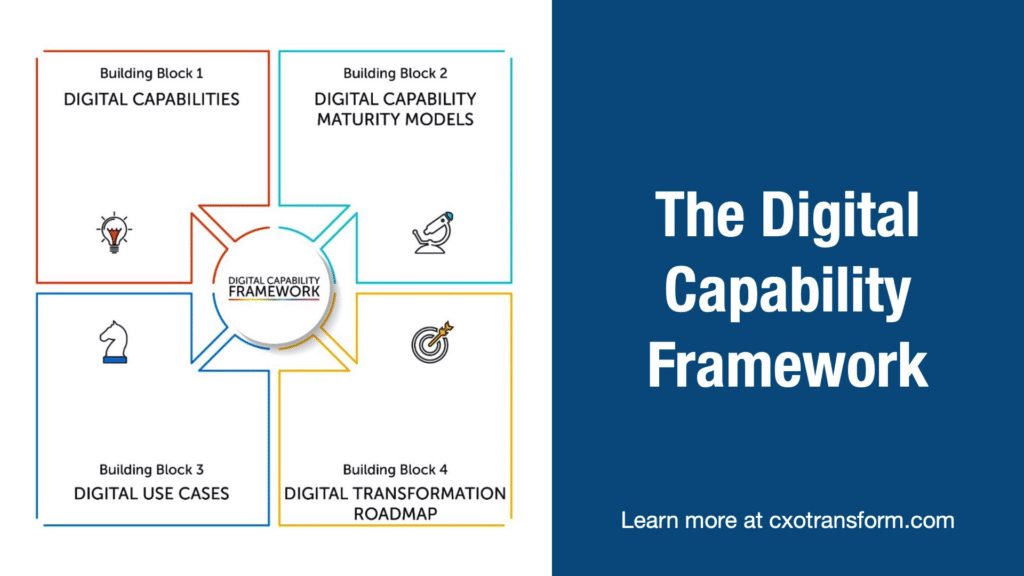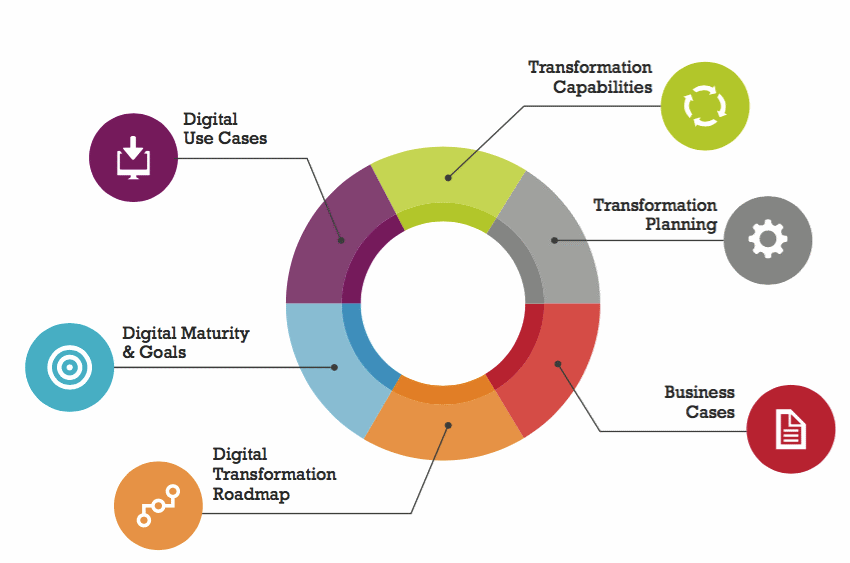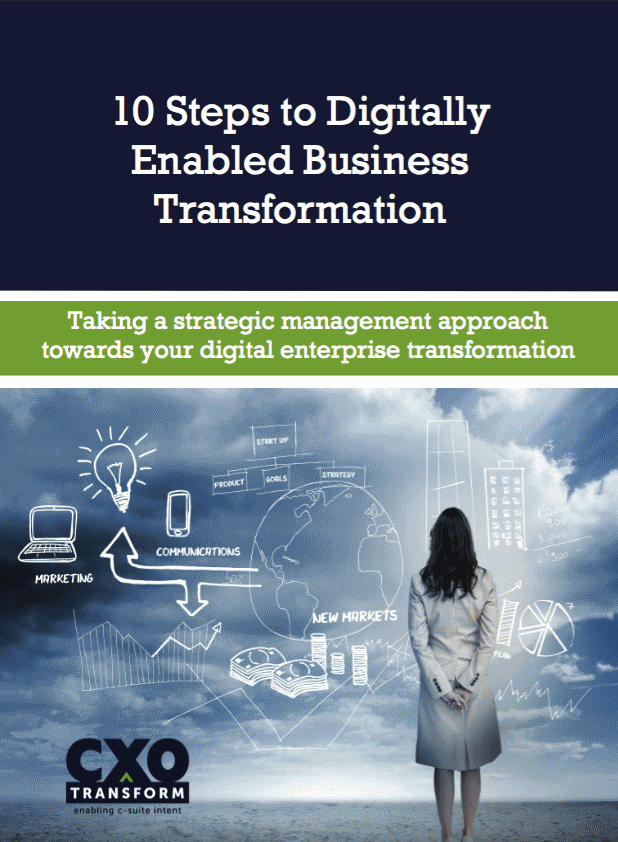What is The Digital Capability Framework?
The Digital Capability Framework is a digital transformation framework designed to help companies innovate and orchestrate digitally enabled business transformation. It helps companies analyse their current situation and identify new business cases, which are enabled by technology trends. The Digital Capability Framework consists of the four building blocks shown in the illustration below.

What is Digital Capability?
Digital capability in business refers to an organisation's ability to leverage digital technologies and processes to achieve business goals and objectives. It encompasses a range of skills, knowledge, and behaviours that enable individuals and teams to use digital technologies effectively and efficiently.

Digital capability in business includes areas such as digital strategy, digital skills and competencies, technology infrastructure, data analytics, digital marketing, and customer experience. It is not just about having the right tools and technologies in place, but also about having the right people with the right skills to use them effectively.
Organisations with strong digital capabilities are better equipped to compete in today's digital economy. They are able to leverage data insights to make better business decisions, deliver more personalised customer experiences, and operate more efficiently and effectively.
Digital capability is also a key driver of innovation and growth in businesses. It enables businesses to develop new products and services, explore new business models, and enter new markets.
Overall, digital capability is an essential component of business success in the digital age. Businesses that invest in developing and strengthening their digital capabilities are better positioned to succeed in today's rapidly evolving business landscape.
What is the Importance of Digital Capability?
Digital capability is essential for organisations and individuals in the digital age because it allows them to effectively leverage digital technologies to achieve their goals and objectives. Here are some key reasons why digital capability is important:
Enables digital transformation
Organisations need strong digital capabilities to successfully navigate digital transformation. Digital capability allows organisations to develop and implement a comprehensive digital strategy, effectively use data and analytics, and provide a better customer experience.
Improves efficiency and productivity
Digital capability enables individuals and organisations to work more efficiently and productively. It allows them to automate processes, collaborate more effectively, and make better decisions based on data insights.
Enhances innovation
Digital capability is a key driver of innovation in organisations. It allows them to develop new products and services, explore new business models, and enter new markets.
Provides a competitive advantage:
Organisations with strong digital capabilities are better positioned to compete in the digital economy. They are able to provide a better customer experience, operate more efficiently, and make better decisions based on data insights.
Enables growth
Digital capability is a critical component of growth in organisations. It allows them to enter new markets, develop new products and services, and explore new business models.
Digital capability is an essential component of success in the digital age. Organisations and individuals that invest in developing and strengthening their digital capability are better positioned to succeed in today's rapidly evolving digital landscape.
What are Digital Capabilities Examples?
Digital capabilities encompass a wide range of skills, knowledge, and behaviours that enable individuals and organisations to effectively use digital technologies to achieve their goals and objectives. Here are some examples of digital capabilities:
Digital strategy
The ability to develop and implement a comprehensive digital strategy that aligns with business goals and objectives.
Digital literacy
The ability to effectively use digital technologies such as computers, mobile devices, and software applications.
Data analytics
The ability to effectively collect, analyse, and interpret data to inform decision-making processes.
Digital marketing
The ability to effectively use digital channels such as social media, email, and online advertising to promote products and services.
Customer experience
The ability to use digital technologies to provide a seamless and personalised customer experience across all touchpoints.
Technology infrastructure
The ability to effectively manage and maintain digital infrastructure such as networks, servers, and cloud services.
Cybersecurity
The ability to effectively manage and mitigate cybersecurity risks to protect digital assets and sensitive data.
Digital innovation
The ability to use digital technologies to develop new products and services, explore new business models, and enter new markets.
Digital capabilities are essential for success in the digital age. Organisations and individuals that possess these capabilities are better positioned to succeed in today's rapidly evolving digital landscape.

What is a Digital Capability Model?
A digital capability model – like the Digital Capability Framework – is a framework or model that outlines the key digital capabilities required for an organisation to effectively leverage digital technologies to achieve its business goals and objectives. It provides a structured approach to defining and assessing an organisation's digital capabilities and identifying areas for improvement.
A digital capability model typically includes a set of digital capabilities that are relevant to the organisation's industry and business goals. These capabilities may include areas such as digital strategy, customer experience, data analytics, digital marketing, and technology infrastructure.
The digital capability model is used to assess the organisation's current capabilities in each of these areas and identify areas for improvement. This assessment may involve a variety of methods, such as surveys, interviews, and performance metrics.
Once the organisation's current digital capabilities have been assessed, the digital capability model can be used to define a roadmap for improving those capabilities. This may involve prioritising investments in certain areas, developing new processes and procedures, or hiring new talent with the necessary digital skills.
A digital capability model is a valuable management tool for organisations looking to improve their digital capabilities and achieve success in the digital age. By assessing their current capabilities and developing a roadmap for improvement, organisations can stay competitive and stay ahead of the curve in an increasingly digital world.
What is the Meaning of Digital Capacity?
Digital capacity refers to an organisation's or individual's ability to use digital technologies to effectively achieve their goals and objectives. It encompasses a range of skills, knowledge, and behaviours that enable individuals and organisations to use digital technologies in an effective and efficient manner.
Digital capacity is not just about having the right tools and technologies in place, but also about having the right people with the right skills to use them effectively. It includes areas such as digital literacy, digital skills and competencies, technology infrastructure, data analytics, digital marketing, and customer experience.
Having a strong digital capacity enables individuals and organisations to effectively leverage digital technologies to achieve their goals and objectives. It allows them to work more efficiently, improve decision-making processes, and provide better customer experiences.
Digital capacity is also a key driver of innovation and growth in organisations. It enables organisations to develop new products and services, explore new business models, and enter new markets.
Overall, digital capacity is an important component of success in the digital age. Organisations and individuals that invest in developing and strengthening their digital capacity are better positioned to succeed in today's rapidly evolving digital landscape.
What Does The Digital Capability Framework Do?
The Digital Capability Framework is essentially a digital transformation framework designed to help companies innovate and orchestrate digitally enabled business transformation. It helps companies analyse their current situation and identify new business cases, which are enabled by technology trends.
Addressing both the technical and people side of transformation, this digital transformation framework enables transformation leaders to obtain clarity about what maturity level their organisation has in terms of six digital capabilities, what maturity level they wish to achieve, and how they plan to do that.
Digital use cases help them develop a clear picture of the processes to be optimised and the technologies that should be used; and a tailored plan to transform the organisation into a digital enterprise can then be established and implemented.
Digital Capability Framework Building Blocks
The Digital Capability Framework consists of the following four building blocks:
Building Block 1: Digital Capabilities
Digital Capabilities define the six key functions and skills required to become a digital enterprise. These Digital Capabilities fall into two categories. Digital Transformation Enablers and Digital Transformation Goals.
Building Block 2: Digital Capability Maturity Models
These are the structured assessments used to evaluate the Digital Maturity of an organisation.
The general concept of maturity models dates back to the 1980s when IBM started developing a maturity model for software processes. In 1991 this evolved into the Capability Maturity Model for software known as CMM, which later became CMMI.
Digital Capability Maturity Models are based on the CMM measurement principles.A digital maturity model measures the maturity of the digitisation process of an organisation. It supports the evaluation of the as-is situation in each of the six DCF capabilities.
It's a generic evaluation model incorporating the BTM2 phases in order to support holistic analysis. The Digital Capability Maturity Model also serves as a tool to investigate the transformation needs for each capability for a particular to-be scenario.
Building Block 3: Digital Use Cases
Once you know where you are and where you need to go, you next need to figure out how you're going to get there. How will you actually achieve the higher maturity for a particular digital capability?
Digital Use Cases provide ways of showing how to reach specific goals, which will enhance an organisation’s Digital Capability. They typically show how organisations in specific industries can gain competitive advantages through digital transformation. They're practical scenarios which provide a description, information about the current situation, the value proposition, benefits and perhaps risks also.
Building Block 4: Digital Transformation Roadmap
When you have a clear understanding about the benefits of individual Digital Use Cases and their business impact and implementation efforts, you next need to define the digital transformation roadmap. This roadmap provides an overview about the realisation timeframe of the individual Digital use Cases along with their impact on the Digital Capabilities.
How To Started Using The Digital Capability Framework
Here are some steps to get started with using the Digital Capability Framework:
- Define your business goals: Before you begin using the Digital Capability Framework, it's important to have a clear understanding of your business goals and objectives. This will help you to identify which digital capabilities are most important for your organisation to develop.
- Identify the digital capabilities you need: Based on your business goals and objectives, identify the digital capabilities that are most important for your organisation to develop. These may include areas such as digital strategy, customer experience, data analytics, digital marketing, and technology infrastructure.
- Assess your current capabilities: Once you've identified the digital capabilities you need, assess your organisation's current capabilities in each of these areas. This may involve conducting surveys, interviews, and performance metrics to gain a better understanding of your current capabilities.
- Identify areas for improvement: Based on your assessment, identify areas where your organisation needs to improve its digital capabilities. These may include areas where you are falling behind competitors, areas where you are not meeting customer expectations, or areas where you are not using data effectively.
- Develop a roadmap for improvement: Once you've identified areas for improvement, develop a roadmap for improving your digital capabilities. This may involve prioritising investments in certain areas, developing new processes and procedures, or hiring new talent with the necessary digital skills.
- Monitor progress and adjust as needed: Finally, it's important to monitor your progress and adjust your roadmap as needed. This may involve regularly assessing your digital capabilities, measuring performance metrics, and making adjustments to your roadmap based on new information or changing business goals.
By following these steps, you can begin using the Digital Capability Framework to assess your organisation's digital capabilities and develop a roadmap for improvement. Remember, digital transformation is a journey, and it's important to continually assess your progress and adjust your approach as needed to stay ahead of the curve in an increasingly digital world.

A Strategic Digital Transformation Framework
The Digital Capability Framework helps digital transformation leaders such as the CIO take a structured business orientated approach to transformation, which gives rise to closer collaboration between IT and the Business and increased stakeholder confidence.
Holistic and integrated transformation management, which is underpinned by strong business cases and transformation capability, are just some of the advantages of leveraging the DCF. This facilitates greater return on investment and competitive advantage – all of which has been driven by the likes of the CIO.
Free Digital Capability Framework Download
Download this short guide to the Digital Capability Framework.

Where The Digital Capability Framework Came From
The framework is independent of any technology type and is the result of extensive research and collaboration between SAP Business Transformation Services and their partners from academic and business arenas throughout the world. It is a digital transformation framework that can be adopted and deployed by any company regardless of industry.
Where Can I Find Digital Capability Framework Experts?
The Digital Capability Framework is available to the public domain. You will find many transformation consultants skilled in using it. If you want to become an expert yourself discover how you can do that online at your own pace.

Who Uses The Digital Capability Framework?
Companies such as Unilever, SAP, DHL and many others have used the Digital Capability Framework.
Where Can I Learn More About The Digital Capability Framework?
1. Read this Digital Enterprise Transformation Book Review
2. Read 10 Steps to Digitally Enabled Business Transformation
3. Listen on Apple to Rob Llewellyn introduce the Digital Capability Framework
Also learn about the THRIVE Digital Business Transformation Management Framework
